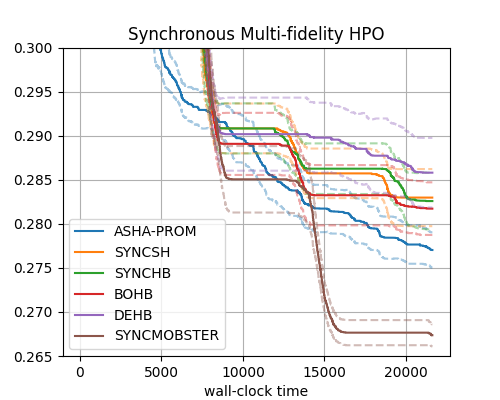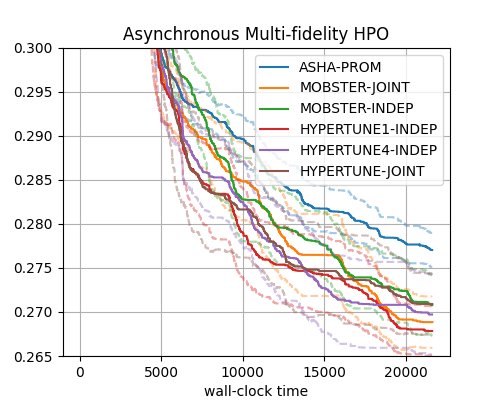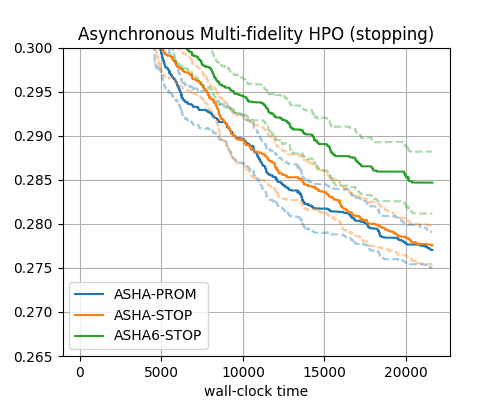Comparison of Methods
In this section, we present an empirical comparison of all methods discussed in this tutorial. The methodology of our study is as follows:
We use the NASBench-201 benchmark (CIFAR100 dataset)
All methods are run with a
max_wallclock_timelimit of 6 hours (or 21600 seconds). We plot minimum validation error attained as function of wallclock time (which, in our case, is simulated time)Results are aggregated over a number of repetitions. The number of repetitions is 50 for SYNCSH, SYNCHB, BOHB, DEHB, ASHA-STOP, ASHA-PROM, ASHA6-STOP and SYNCMOBSTER, while MOBSTER-JOINT, MOBSTER-INDEP, HYPERTUNE1-INDEP, HYPERTUNE4-INDEP and HYPERTUNE-JOINT are repeated 30 times. Figures plot the interquartile mean in bold and a bootstrap 95% confidence interval for this estimator in dashed lines (the IQM is a robust estimator of the mean, but depends on more data than the median)
SYNCSH, ASHA-STOP, ASHA-PROM, MOBSTER-JOINT, MOBSTER-INDEP, HYPERTUNE1-INDEP use 1 bracket, HYPERTUNE4-INDEP, HYPERTUNE-JOINT use 4 brackets, and SYNCHB, BOHB, DEHB, SYNCMOBSTER use the maximum of 6 brackets
In SYNCSH, SYNCHB, ASHA-STOP, ASHA-PROM, ASHA6-STOP, new configurations are drawn at random, while BOHB, SYNCMOBSTER, MOBSTER-JOINT, MOBSTER-INDEP, HYPERTUNE1-INDEP, HYPERTUNE4-INDEP, HYPERTUNE-JOINT are variants of Bayesian optimization. In DEHB, configurations in the first bracket are drawn at random, but in later brackets, they are evolved from earlier ones
ASHA-STOP, ASHA6-STOP use early stopping, while SYNCSH, SYNCHB, BOHB, SYNCMOBSTER, ASHA-PROM, MOBSTER-JOINT, MOBSTER-INDEP, HYPERTUNE1-INDEP, HYPERTUNE4-INDEP, HYPERTUNE-JOINT use pause-and-resume. DEHB is a synchronous method, but does not resume trials from checkpoints (except in the very first bracket)
Here are results, grouped by synchronous decision-making, asynchronous decision-making (promotion type), and asynchronous decision-making (stopping type). ASHA-PROM results are repeated in all plots for reference.
|
|---|
Synchronous Multi-fidelity HPO |
|
|---|
Asynchronous Multi-fidelity HPO (promotion) |
|
|---|
Asynchronous Multi-fidelity HPO (stopping) |
These results are obtained on a single benchmark with a rather small configuration space. Nevertheless, they are roughly in line with results we obtained on a larger range of benchmarks. A few conclusions can be drawn, which may help readers choosing the best HPO method and its configuration for their own problem.
Asynchronous methods outperform synchronous ones in general, in particular when it comes to any-time performance. A notable exception (on this benchmark) is SYNCMOBSTER, which performs en par with the best asynchronous methods.
Among the synchronous methods, SYNCMOBSTER performs best, followed by BOHB. SYNCHB and SYNCSH perform very similar. The performance of DEHB is somewhat disappointing on this benchmark.
The best-performing methods on this benchmark are MOBSTER-JOINT and HYPERTUNE1-INDEP, with HYPERTUNE4-INDEP a close runner-up. For MOBSTER, the joint multi-task surrogate model should be preferred, while for HYPERTUNE, the independent GPs model works better.
On this benchmark, moving to multiple brackets does not pay off for the asynchronous methods. However, on benchmarks where the choice of \(r_{min}\) is more critical, moving beyond successive halving can be beneficial. In such cases, we currently recommend to use HYPERTUNE-INDEP, whose adaptive weighting and bracket sampling is clearly more effective than simpler heuristics used in Hyperband or BOHB.


